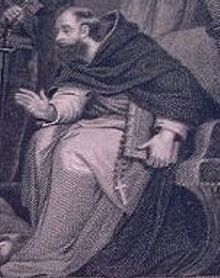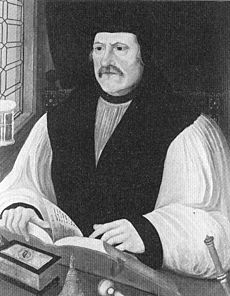John Feckenham facts for kids
Quick facts for kids John Feckenham |
|
 Detail of Lady Jane Grey and Feckenham – Artist likely Northcote and Engraved by J. Rogers |
|
| Born | c. 1515 in Feckenham Forest, Worcestershire |
|---|---|
| Died | October 1584 in Wisbech |
| Church | Roman Catholic |
| Education | Gloucester Hall, Oxford |
| Offices held | Rector of Finchley, Rector of Solihull, Dean of St Paul's, Last Abbot of Westminster Mary I's Chaplain and Confessor |
John Feckenham (born around 1515, died October 1584) was an important English church leader. He was the very last abbot (the head of a monastery) of Westminster Abbey. He was also known by other names like John Howman.
Contents
John Feckenham's Early Life and Education
John Feckenham was born in a place called Feckenham in Worcestershire, England. His family were farmers. His real family name was Howman, but when he became a monk, he chose to be known by the name of his hometown.
Becoming a Monk and Student
John started his education with his local priest. Then, he went to a special school at Evesham Abbey, which was a monastery. When he was 18, he went to Gloucester Hall, Oxford, to study as a Benedictine student. After finishing his first degree, he went back to Evesham Abbey to become a monk.
In 1537, he returned to Oxford and earned another degree in 1539. He was still at Evesham Abbey when it was closed down in 1540. This happened during a time called the Dissolution of the Monasteries, when King Henry VIII closed many monasteries in England. After this, John received some money each year and went back to Oxford.
Working for Bishops
Soon after, John Feckenham became a chaplain (a church assistant) for John Bell, who was the Bishop of Worcester. From 1543 to 1549, he worked for Edmund Bonner, the Bishop of London. In 1544, Bishop Bonner made him the rector (a church leader in charge of a parish) of Solihull.
John Feckenham became well-known as a great preacher. He was also very good at debates, known for his sharp mind and kindness.
Imprisonment and Debates
Around 1549, Bishop Bonner lost his position. After this, Thomas Cranmer sent John Feckenham to the Tower of London. Even in prison, John was known for his learning and speaking skills. He was so good that he was sometimes allowed out of prison to take part in public debates. He debated against important figures like John Hooper and John Jewel.
John Feckenham During Queen Mary I's Reign
When Queen Mary I became queen in 1553, she released John Feckenham from prison. He went back to work for Bishop Bonner. He quickly gained important church positions, becoming a leader at St Paul's Cathedral and a rector in different towns. He also became Queen Mary's chaplain and confessor (someone she would talk to about her spiritual life).
Debates and Kindness
John Feckenham took part in more debates, including those against Thomas Cranmer, Hugh Latimer, and Nicholas Ridley. However, he did not like the harsh ways some people were treated during this time. He used his influence with Queen Mary to help Protestants, trying to get them pardons or lighter punishments.
He was even sent by the Queen to prepare Lady Jane Grey for her death. When Queen Mary's half-sister, Elizabeth, was sent to the Tower in 1554, John Feckenham spoke up for her. He tried to help her gain freedom, even if it meant upsetting the Queen.
Becoming Abbot of Westminster
In 1556, John Feckenham earned a special degree from the University of Oxford. Later that year, Westminster Abbey was brought back to life as a monastery, and John Feckenham was chosen to be its abbot. Under his leadership, the traditional monastic life started again. He also reopened Westminster School and restored the shrine of St Edward the Confessor.
John Feckenham Under Queen Elizabeth I

When Queen Elizabeth I became queen, John Feckenham was still a very important figure. He was the last abbot to sit in England's Parliament. He strongly disagreed with the new laws about religion. He refused to take the Oath of Supremacy, which would have recognized the Queen as the head of the church.
Imprisonment and Charity Work
Because he refused to accept the new religious changes, Westminster Abbey was closed again in 1560. Within a year, Archbishop Matthew Parker sent John Feckenham to the Tower of London. He was imprisoned for refusing to attend public church services and for speaking out against the new religion.
For the rest of his life, John Feckenham was mostly kept in prison or under the care of bishops. Even when he was a prisoner, he was known for his kindness. When he was briefly released on bail, he lived in Holborn, London, and did many charitable acts.
He was known for helping the poor wherever he went. He built a public water system in Holborn and a place for the poor to stay in Bath. Every day, he gave milk from twelve cows to the sick. He also took care of orphans and encouraged young people in London to play sports on Sundays by giving out prizes.
Final Years and Legacy
In 1577, he was placed under the care of Richard Cox, the Bishop of Ely. Bishop Cox said that John Feckenham was a kind person, but very firm in his Catholic beliefs. In 1580, he was moved to Wisbech Castle. There, he had a good influence on the other prisoners. He also paid to fix the road and set up a market cross in the town.
John Feckenham died in prison in October 1584, 24 years after Queen Mary's death. He was buried in the St Peter and St Paul's Church in Wisbech.
John Feckenham's Published Works
John Feckenham wrote several books and papers during his life. Some of his surviving works include:
- A Conference Dialoguewise held between the Lady Jane Dudley and Master J. F. ... touching the faith and belief of the sacrament and her religion (London 1554)
- Two Homilies on the first, second, and third Articles of the Creed (London 1555)
- A notable Sermon at the Exequies of Joan, Queen of Spain (London 1555)
- The Oration of Dr. F. made in the Parliament House (London 1559)
- The Declaration of such Scruples and Stays of Conscience touching the Oath of Supremacy (London 1566)
- Objections or Assertions made against Mr. John Gough’s Sermon preached in the Tower of London (London 1570)
- Rules to be Observed at the Bathe (1576)
John Feckenham in Movies
John Feckenham was played by the actor Michael Hordern in the 1986 historical movie Lady Jane. In the film, his scenes show his friendship with Lady Jane Grey.

